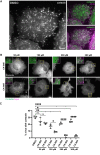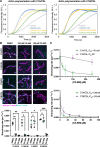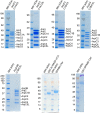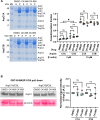CK-666 and CK-869 differentially inhibit Arp2/3 iso-complexes
- PMID: 39009834
- PMCID: PMC11316031
- DOI: 10.1038/s44319-024-00201-x
CK-666 and CK-869 differentially inhibit Arp2/3 iso-complexes
Abstract
The inhibitors, CK-666 and CK-869, are widely used to probe the function of Arp2/3 complex mediated actin nucleation in vitro and in cells. However, in mammals, the Arp2/3 complex consists of 8 iso-complexes, as three of its subunits (Arp3, ArpC1, ArpC5) are encoded by two different genes. Here, we used recombinant Arp2/3 with defined composition to assess the activity of CK-666 and CK-869 against iso-complexes. We demonstrate that both inhibitors prevent linear actin filament formation when ArpC1A- or ArpC1B-containing complexes are activated by SPIN90. In contrast, inhibition of actin branching depends on iso-complex composition. Both drugs prevent actin branch formation by complexes containing ArpC1A, but only CK-869 can inhibit ArpC1B-containing complexes. Consistent with this, in bone marrow-derived macrophages which express low levels of ArpC1A, CK-869 but not CK-666, impacted phagocytosis and cell migration. CK-869 also only inhibits Arp3- but not Arp3B-containing iso-complexes. Our findings have important implications for the interpretation of results using CK-666 and CK-869, given that the relative expression levels of ArpC1 and Arp3 isoforms in cells and tissues remains largely unknown.
Keywords: Arp2/3 Iso-Complexes; CK-666; CK-869; Inhibition; SPIN90.
© 2024. The Author(s).
Conflict of interest statement
The authors declare no competing interests.
Figures











References
-
- Baggett AW, Cournia Z, Han MS, Patargias G, Glass AC, Liu SY, Nolen BJ (2012) Structural characterization and computer-aided optimization of a small-molecule inhibitor of the Arp2/3 complex, a key regulator of the actin cytoskeleton. ChemMedChem 7:1286–1294 10.1002/cmdc.201200104 - DOI - PMC - PubMed
MeSH terms
Substances
Grants and funding
LinkOut - more resources
Full Text Sources
Research Materials
Miscellaneous

